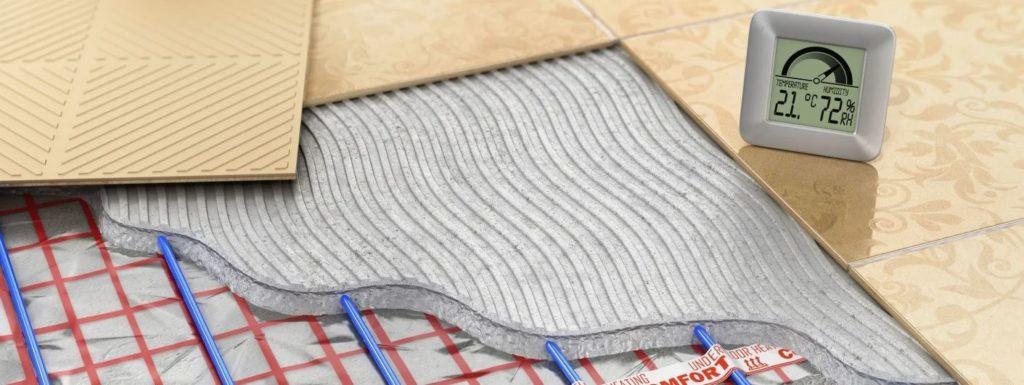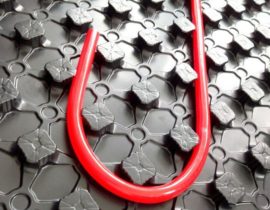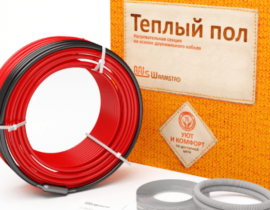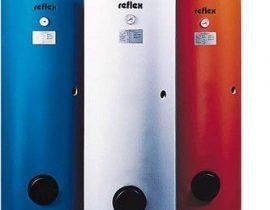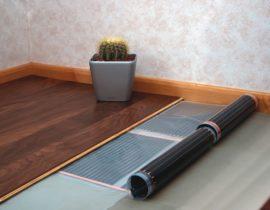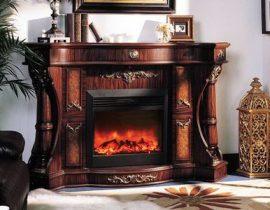Modern underfloor heating systems are increasingly becoming a replacement or addition to the traditional heating option with radiators placed on the wall. They benefit from comfort and economy, but they can also create a lot of questions. One of the main ones is which underfloor heating is better, water or electric?
Content
- General information about underfloor heating systems
- Comparison of water and electric underfloor heating
- The complexity of the organization of the system and its installation
- Reliability and durability
- maintainability
- Thermal dynamics
- Need for approval
- economy
- Price
- Questions and answers
- Video review of underfloor heating
General information about underfloor heating systems
All warm floors use the same principle - the placement of heat sources under the floor covering.
This is the reason for their main advantages:
- Warming up part of the interior space rooms with the lowest temperature - the floor.
- Uniform heat flow distribution from heaters over the entire area, due to which there are no overheated and cold zones in the room and, as a result, air flows between them (drafts).
- heat concentration specifically in the interior, which increases the efficiency of energy use and reduces heating costs.
- Freeing walls from radiators, thermal mains and other heating devices, which simplifies the finish.
Two main types of systems are widely used:
- Water heated floor. The source of heat in this case is the heat carrier (water, glycol solutions, etc.) circulating in pipe loops laid in a screed or freely placed under a finishing coating (which is much less common). The system can be autonomous with a heating boiler and a circulation pump or connected to centralized heating lines.
- Electric. In this case, heating elements connected to the internal household power supply are used.
- resistive cables (cable floor heating, the simplest and most common option);
- films with a grid of conductors placed between layers with high resistance or conductive paste (film floor heating, which is also called radiant or infrared);
- carbon rods (the most modern systems, called core underfloor heating).
Each of the designs has its own advantages and disadvantages, so when choosing an option for installation in an apartment or house, they need to be compared according to some general indicators.
Comparison of water and electric underfloor heating
For a balanced choice of a "warm floor" system for an apartment in an apartment building or private house the following characteristics of systems and their components should be taken into account.
The complexity of the organization of the system and its installation
The "rating" of underfloor heating according to the complexity of the project and installation is as follows:
Water
The most difficult option. The system requires:
- In most cases, the organization of more than one coolant circulation circuit in order to ensure an acceptable level of temperature drop between the "supply" and "return".
- Installation of a manifold and distribution unit to combine several circuits.
- Filling screed or installation of flooring systems.
- The inclusion of a circulation pump to create the pressure necessary to move the liquid in the circuit.
- Compliance with the laying rules, first of all, compliance with the bending radius of the pipes in order to prevent mechanical stress and destruction of the line under pressure.
In order to correctly lay the contours and assemble the system, considerable experience and skill are required. Most home craftsmen are unlikely to cope with this task on their own.
Carbon rod
The design is a kind of mat with closely spaced (at a distance of about 10 cm, depending on the manufacturer's standards) rods in reliable insulation, connected in parallel by two current-carrying tires. You can mount it both in the screed and under the tile adhesive.
Despite the apparent convenience of the design, laying can be a certain complexity. For 90 degree turnsaboutand even more so 180about, you will need to cut one bus, and then connect the ends with the conductors from the kit. To achieve the reliability and safety of connections, you need a tool (building hair dryer and crimping pliers) and the ability to work with it.
cable electric
The resistive cable is easy to lay, and it is not difficult to calculate the heating element for rooms of any size.
You need to pay attention only to some nuances, such as:
- accurate pouring during installation in a screed, so as not to damage the cable insulation;
- high-quality thermal insulation from load-bearing structures, so as not to lose energy for their heating;
- uniform distribution of heat, which implies either a rigorous calculation of the distances between the turns of the cable, or the selection of additional radiators.
Film electric
The easiest option to install is to roll out a roll of film or a thermal mat and mount a clean floor covering on top.
The only difficulty is to ensure high-quality insulation at the points of connection of the electrical network cable.
Reliability and durability
 These indicators reflect the maximum allowable service life of the system and the probability of failure-free operation during this period, subject to the conditions of installation and operation.
These indicators reflect the maximum allowable service life of the system and the probability of failure-free operation during this period, subject to the conditions of installation and operation.
For various underfloor heating systems, they are:
- water - up to 50 years and more than 90%;
- pivotal – 20-25 years at 70-75%;
- cable – 15 years and about 70%;
- film — 15 years, about 40%.
It should be noted that for the "record holder" - the water floor, this does not take into account the reliability and durability of the circulation pump, the collector assembly, control equipment (pressure gauges, thermostats, etc.). All of them significantly (by 20-25%) reduce the above indicators.
maintainability
From the point of view of repair when part of the system fails, underfloor heating can be characterized by:
- Rod - the best option. First, the failure of one rod does not lead to the failure of the entire system (the elements are connected in parallel). Secondly, for repair, it is enough to cut out a section of current-carrying tires with a non-working rod and mount another one in its place.
- Water. The material of the lines allows the removal of the damaged section and its replacement with a new pipe section. The biggest problem arises when installing in a screed - the amount of work increases significantly.
- Film. Similarly to the rod, you can replace the film section. It is inferior to the rod one for only one reason - when dismantling the finishing coating, there is a danger of damaging several sections.
- Cable. Not repairable - resistive cable manufacturers prohibit the replacement of sections, the entire heating element will have to be changed.
A good method for solving problems with a cable floor is to section it even at the installation stage. By dividing it into segments, connecting them in series and in parallel, it is possible to provide the required power of the heat source and significantly increase maintainability - only the failed section will require replacement.
Thermal dynamics
This indicator characterizes the rate of temperature increase by the heating element and its transfer to the serviced space:
- Water. It is distinguished by the greatest inertia, which is due to the total heat capacity of the liquid in the system and the screed. This somewhat reduces the comfort of use (the warm-up time increases significantly), but allows you to heat the coolant not constantly, but periodically, at fairly large intervals.
- Cable. It has a much greater inertia, since the air in the room will begin to warm up only after the screed is heated. With the right choice of subfloor material (its heat capacity), it is possible to ensure that the temperature is maintained for a long time after the heater is turned off.
- Rod, depending on the method of installation, shows results similar to a film (when installed under a finishing coat) or cable (when installed in a screed).
- Film electric - quickly warms up and heats the air in the room, since it works only with a fine coating. It also cools down quickly.
Need for approval
In this respect, water systems are inferior to their electric counterparts. The latter, regardless of type, can be mounted without the approval of the project with the supervisory authorities. The exception is the situation when the power turns out to be more than the intra-house power supply networks can provide. In this case, their modernization will be required, which is carried out by the supplier company.
Installation of a water heated floor requires coordination in any case, except for installation in a private house. Moreover, the chance to get permission is only for the autonomous system. Its power from centralized heating mains is prohibited in most regions and settlements.
economy
Loud statements by system manufacturers about the cost-effectiveness of one or another option, superior to analogues, have nothing to do with reality.
In reality, in order to heat a room of a certain area, it is necessary to transfer to it, ceteris paribus, the same amount of energy from any heating system. It does not matter which heater will do this.
Accordingly, the efficiency is determined only by the correct preparatory work - if the heat insulator is correctly selected and laid, the efficiency of any warm floor approaches 95-96%.
We can talk about economy only if:
- Comparisons with other heating systems, such as radiators.In this case, any warm floors win.
- Use of a water circuit with a gas boiler. In this option, the heating costs will be significantly less than when using electrical equipment. However, the cost of the heater itself increases the cost of purchasing the system.
Price
At present, there is a situation in which it is difficult to give priority to water or electrical systems. The use of high-quality materials and components has made the cost of underfloor heating of all types approximately the same - within 11-15 US dollars per 1 sq.m. heated room (including installation by specialists).
Thus, when choosing and being able to, it is worth giving preference to the “warm floor” water system, which is somewhat superior to electrical counterparts in terms of the sum of indicators. The arguments against this are the complexity and, most importantly, the mandatory coordination with the supervisory authorities (the latter is not relevant for installation in a private house).
Questions and answers
For electric, the savings will be about 30% of the cost of materials and equipment, for water - 50-55%.
In bathrooms, kitchens, bathrooms and other rooms with high humidity, it is impossible to mount only film heated floors. The rest work well in such difficult conditions.
As a rule, the issue with furniture is decided at the design stage - heaters are not placed under it.However, if it is possible to move furniture after installing the heating system, you should choose the option with laying in a screed - the likelihood of damage to the elements in this case is much less.
Modern warm floors of all types work almost silently. In the case of water, slight noise is possible during the operation of the pump and when air enters the circuit. The first problem is easy to solve by choosing the right place for the pump and the manifold assembly, the second - by including an air vent in the circuit.
If they do not live in it permanently in cold weather, it is better to choose a film one - it will quickly create a comfortable temperature. For permanent residence, the same considerations should be followed as for any private house.
Video review of underfloor heating








